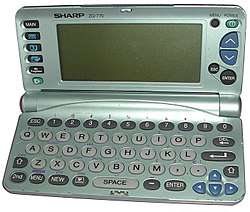Electronic organizer
An electronic organizer (or electric organizer) is a small calculator-sized computer, often with an built-in diary application and other functions such as an address book and calendar. It normally has a small alphanumeric keypad and an LCD screen of one, two, or three lines. The electronic diary or organizer was invented by an Indian businessman Satyan Pitroda in 1975. He is regarded as one of the earliest pioneers of hand-held computing because of his invention of the Electronic Diary in 1975.[1]

They were very popular especially with businessmen during the 1990s, but because of the advent of personal digital assistants, and later smartphones in the 2000s and 2010s respectively, both of which have a larger set of features, electronic organizers are mostly seen today for research purposes. One of the leading research topics being the study of how electronics can help people with mental disabilities use this type of equipment to aid their daily life.[2] Electronic organizers have more recently been used to support people with Alzheimer's disease to have a visual representation of a schedule.[3]
Casio digital diary
Casio digital diaries were produced by Casio in the early and mid 1990s, but have since been entirely superseded by Mobile Phones and PDAs.
Other electronic organizers
While Casio was a major role player in the field of electronic organizers there were many different ideas, patent request, and manufacturers of the electronic organizers.[4] Rolodex who is namely known for their index card holders in the 1980s, Sharp Electronics who is mostly known for their printers and audio visual equipment, and lastly Royal electronics were all large contributors to the electronic organizer in its heyday.
Features
- Telephone directory
- Schedule keeper: Keep track of appointments.
- Memo function: Store text data such as price lists, airplane schedules, and more.
- To do list: Keep track of daily tasks, checking off items as you complete them.
- World time: Find out the current time in virtually any location on the globe.
- Secret memory area: The secret memory area keeps personal data private. Once a password is registered, data is locked away until the password is used to access the secret area.
- Alarm
- Metric conversion function: Conversion between metric units and another measurement unit.
- Currency conversion function
- Game: Some machines included a game such as Poker or Blackjack.
References
- https://www.computerhistory.org/revolution/mobile-computing/18/318/1716
- Bryen, Diane Nelson; Carey, Allison; Friedman, Mark (February 2007). "Cell Phone Use by Adults With Intellectual Disabilities". Intellectual and Developmental Disabilities. 45 (1): 1–2. doi:10.1352/1934-9556(2007)45[1:cpubaw]2.0.co;2. ISSN 1934-9491.
- Imbeault, Hélène; Pigot, Hélène; Bier, Nathalie; Gagnon, Lise; Marcotte, Nicolas; Giroux, Sylvain; Fülüp, Tamas (2011). Abdulrazak, Bessam; Giroux, Sylvain; Bouchard, Bruno; Pigot, Hélène; Mokhtari, Mounir (eds.). "Interdisciplinary Design of an Electronic Organizer for Persons with Alzheimer's Disease". Toward Useful Services for Elderly and People with Disabilities. Lecture Notes in Computer Science. Springer Berlin Heidelberg. 6719: 137–144. doi:10.1007/978-3-642-21535-3_18. ISBN 978-3-642-21535-3.
- , "Combination pager, organizer and radio", issued 1997-06-13